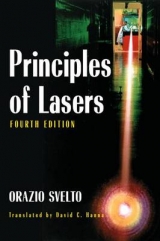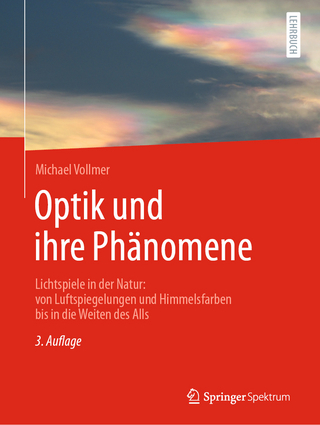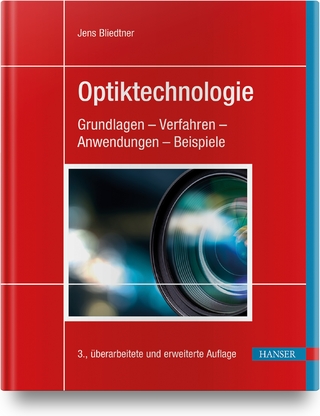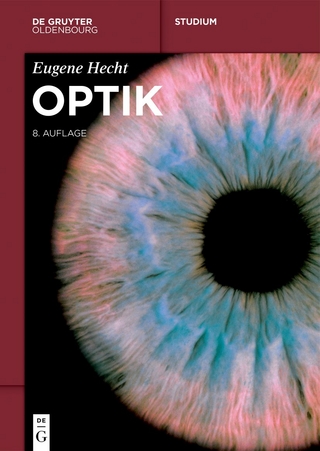
Principles of Lasers
Kluwer Academic / Plenum Publishers (Verlag)
978-0-306-42967-5 (ISBN)
- Titel erscheint in neuer Auflage
- Artikel merken
A greatly extended discussion of the physics of gas discharges. Other important additions include a discussion of some topics from conven- tional optics (e.g., ray matrix methods, Fabry-Perot interferometers, and multilayer dielectric mirrors), Gaussian beam propagation (e.g., the ABeD law), and the theory of relaxation oscillations and active mode-locking.
1. Introductory Concepts.- 1.1. Spontaneous and Stimulated Emission, Absorption.- 1.1.1. Spontaneous Emission.- 1.1.2. Stimulated Emission.- 1.1.3. Absorption.- 1.2. The Laser Idea.- 1.3. Pumping Schemes.- 1.4. Properties of Laser Beams.- 1.4.1. Monochromaticity.- 1.4.2. Coherence.- 1.4.3. Directionality.- 1.4.4. Brightness.- 1.4.5. Short Time Duration.- 1.5. Organization of the Book.- Problems.- 2. Interaction of Radiation with Matter.- 2.1. Introduction.- 2.2. Summary of Blackbody Radiation Theory.- 2.3. Absorption and Stimulated Emission.- 2.3.1. Rates of Absorption and Stimulated Emission.- 2.3.2. Allowed and Forbidden Transitions.- 2.3.3. Line-Broadening Mechanisms.- 2.3.3.1. Homogeneous Broadening.- 2.3.3.2. Inhomogeneous Broadening.- 2.3.3.3. Concluding Remarks and Examples.- 2.3.4. Transition Cross Section, Absorption, and Gain Coefficient.- 2.4. Spontaneous Emission.- 2.4.1. Semiclassical Approach.- 2.4.2. Quantum Electrodynamic Approach.- 2.4.3. Einstein Thermodynamic Treatment.- 2.4.4. Relation between Spontaneous Lifetime and Cross Section.- 2.4.5. Concluding Remarks.- 2.5. Nonradiative Decay.- 2.6. Saturation.- 2.6.1. Saturation of Absorption: Homogeneous Line.- 2.6.2. Gain Saturation: Homogeneous Line.- 2.6.3. Inhomogeneously Broadened Line.- 2.7. Decay of a Many-Atom System.- 2.7.1. Radiation Trapping.- 2.7.2. Superradiance and Superfluorescence.- 2.7.3. Amplified Spontaneous Emission.- 2.8. Degenerate Levels.- 2.9. Molecular Systems.- 2.9.1. Energy Levels of a Molecule.- 2.9.2. Level Occupation at Thermal Equilibrium.- 2.9.3. Radiative and Nonradiative Transitions.- 2.9.4. Quantum Mechanical Calculation of the Radiative Transition Rates.- Problems.- References.- 3. Pumping Processes.- 3.1. Introduction.- 3.2. Optical Pumping.- 3.2.1. Pumping Efficiency.- 3.2.2. Radiative and Transfer Efficiencies.- 3.2.3. Pump Light Distribution.- 3.2.4. Absorption and Power Quantum Efficiencies.- 3.2.5. Concluding Remarks.- 3.3. Electrical Pumping.- 3.3.1. Physical Characteristics of Discharges.- 3.3.2. Electron Impact Excitation.- 3.3.2.1. Electron Impact Cross Section.- 3.3.2.2. Electron Energy Distribution.- 3.3.2.3. Spatial Distribution of the Pump Rate.- 3.3.2.4. The Ionization Balance Equation.- 3.3.2.5. Pump Rate Calculation.- 3.3.3. Excitation by (Near) Resonant Energy Transfer.- Problems.- References.- 4. Passive Optical Resonators.- 4.1. Introduction.- 4.2. Some Topics from Geometrical and Wave Optics.- 4.2.1. Matrix Formulation of Geometrical Optics.- 4.2.2. The Fabry-Perot Interferometer.- 4.2.3. Multilayer-Dielectric Coatings.- 4.3. Photon Lifetime and Cavity Q.- 4.4. Plane-Parallel Resonator.- 4.4.1. Approximate Treatment.- 4.4.2. Fox and Li Treatment.- 4.5. Confocal Resonator.- 4.6. Gaussian Beam Propagation and the ABCD Law.- 4.7. Generalized Spherical Resonator.- 4.7.1. Mode Amplitudes.- 4.7.2. Resonance Frequencies and Diffraction Losses.- 4.7.3. Stability Condition.- 4.8. Unstable Resonators.- 4.8.1. Geometrical-Optics Description.- 4.8.2. Wave-Optics Description.- 4.8.3. Advantages and Disadvantages of Hard-Edge Unstable Resonators.- 4.8.4. Variable-Reflectivity Unstable Resonators.- Problems.- References.- 5. Continuous Wave and Transient Laser Behavior.- 5.1. Introduction.- 5.2. Rate Equations.- 5.2.1. Four-Level Laser.- 5.2.2. Three-Level Laser.- 5.3. CW Laser Behavior.- 5.3.1. Four-Level Laser.- 5.3.2. Three-Level Laser.- 5.3.3. Optimum Output Coupling.- 5.3.4. Laser Tuning.- 5.3.5. Single-Mode Versus Multimode Oscillation.- 5.3.5.1. Reasons for Multimode Oscillation.- 5.3.5.2. Single-Mode Oscillation.- 5.3.6. Two Numerical Examples.- 5.3.7. Frequency Pulling and Limit to Monochromaticity.- 5.3.8. Lamb Dip and Active Stabilization of Laser Frequency.- 5.4. Transient Laser Behavior.- 5.4.1. Relaxation Oscillations in Single-Mode Lasers.- 5.4.2. Spiking Behavior of Multimode Lasers.- 5.4.3. Q Switching.- 5.4.3.1. Methods of Q Switching.- 5.4.3.2. Operating Regimes.- 5.4.3.3. Theory of Active Q Switching.- 5.4.3.4. A Numerical Example.- 5.4.4. Gain Switching.- 5.4.5. Mode Locking.- 5.4.5.1. Methods of Mode Locking.- 5.4.5.2. Mode-Locking Systems.- 5.4.6. Cavity Dumping.- 5.5. Concluding Remarks.- Problems.- References.- 6. Types of Lasers.- 6.1. Introduction.- 6.2. Solid-State Lasers.- 6.2.1. The Ruby Laser.- 6.2.2. Neodymium Lasers.- 6.2.2.1. Nd:YAG.- 6.2.2.2. Nd:Glass.- 6.2.2.3. Other Crystalline Hosts.- 6.2.3. Alexandrite Laser.- 6.3. Gas Lasers.- 6.3.1. Neutral Atom Lasers.- 6.3.1.1. Helium-Neon Lasers.- 6.3.1.2. Copper and Gold Vapor Lasers.- 6.3.2. Ion Lasers.- 6.3.2.1. Argon Laser.- 6.3.2.2. He-Cd Laser.- 6.3.3. Molecular Gas Lasers.- 6.3.3.1. The CO2 Laser.- 6.3.3.2. The CO Laser.- 6.3.3.3. The N2 laser.- 6.3.3.4. Excimer Lasers.- 6.4. Liquid Lasers (Dye Lasers).- 6.4.1. Photophysical Properties of Organic Dyes.- 6.4.2. Characteristics of Dye Lasers.- 6.5. Chemical Lasers.- 6.5.1. The HF Laser.- 6.6. Semiconductor Lasers.- 6.6.1. Photophysical Properties of Semiconductor Lasers.- 6.6.1.1. Energy States in a Semiconductor.- 6.6.1.2. Level Occupation at Thermal Equilibrium.- 6.6.1.3. Radiative and Nonradiative Transitions.- 6.6.1.4. The Quasi-Fermi Levels.- 6.6.2. Semiconductor-Laser Pumping.- 6.6.2.1. The Homojunction Laser.- 6.6.2.2. The Double-Heterojunction Laser.- 6.6.3. Semiconductor Laser Devices and Their Performance.- 6.6.4. Semiconductor Laser Applications.- 6.6.5. Simplified Theory of a Semiconductor Laser.- 6.7. Color-Center Lasers.- 6.8. The Free-Electron Laser.- 6.9. X-Ray Lasers.- 6.10. Summary of Performance Data.- Problems.- References.- 7. Properties of Laser Beams.- 7.1. Introduction.- 7.2. Monochromaticity.- 7.3. Complex Representation of Polychromatic Fields.- 7.4. Statistical Properties of Laser Light and Thermal Light.- 7.5. First-Order Coherence.- 7.5.1. Degree of Spatial and Temporal Coherence.- 7.5.2. Measurement of Spatial and Temporal Coherence.- 7.5.3. Relation Between Temporal Coherence and Monochromaticity.- 7.5.4. Nonstationary Beams.- 7.5.5. Spatial and Temporal Coherence of Single-Mode and Multimode Lasers.- 7.6. Directionality.- 7.6.1. Beams with Perfect Spatial Coherence.- 7.6.2. Beams with Partial Spatial Coherence.- 7.7. Laser Speckle.- 7.8. Brightness.- 7.9. Comparison Between Laser Light and Thermal Light.- 7.10. Higher-Order Coherence.- Problems.- References.- 8. Laser Beam Transformation: Propagation, Amplification, Frequency Conversion, Pulse Compression.- 8.1. Introduction.- 8.2. Transformation in Space: Gaussian Beam Propagation.- 8.3. Transformation in Amplitude: Laser Amplification.- 8.4. Frequency Conversion: Second-Harmonic Generation and Parametric Oscillation.- 8.4.1. Physical Picture.- 8.4.1.1. Second-Harmonic Generation.- 8.4.1.2. Parametric Oscillation.- 8.4.2. Analytical Treatment.- 8.4.2.1. Parametric Oscillation.- 8.4.2.2. Second-Harmonic Generation.- 8.5. Transformation in Time: Pulse Compression.- Problems.- References.- Appendixes.- A Semiclassical Treatment of the Interaction of Radiation with Matter.- B Space-Dependent Rate Equations.- C Theory of Active Mode Locking for a Homogeneous Line.- D Physical Constants.- Answers to Selected Problems.
| Zusatzinfo | 11 black & white illustrations, biography |
|---|---|
| Verlagsort | Dordrecht |
| Sprache | englisch |
| Gewicht | 860 g |
| Themenwelt | Naturwissenschaften ► Physik / Astronomie ► Optik |
| ISBN-10 | 0-306-42967-5 / 0306429675 |
| ISBN-13 | 978-0-306-42967-5 / 9780306429675 |
| Zustand | Neuware |
| Informationen gemäß Produktsicherheitsverordnung (GPSR) | |
| Haben Sie eine Frage zum Produkt? |
aus dem Bereich



